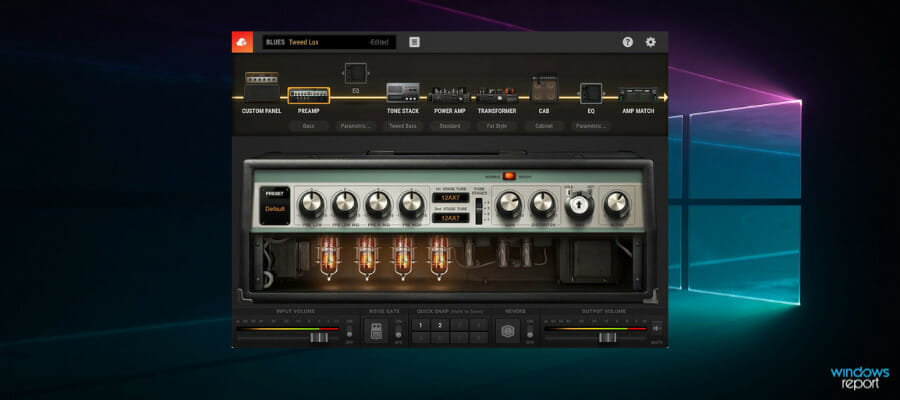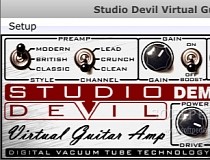
- #STUDIO DEVIL VIRTUAL GUITAR AMP II REVIEW MANUAL#
- #STUDIO DEVIL VIRTUAL GUITAR AMP II REVIEW PRO#
- #STUDIO DEVIL VIRTUAL GUITAR AMP II REVIEW PROFESSIONAL#
- #STUDIO DEVIL VIRTUAL GUITAR AMP II REVIEW DOWNLOAD#
There are enough presets to make most users happy for a long time, but not me. In a left upper corner you will find three main buttons, the second of which opens a browser where you can find a quite impressive number of presets, sorted by more or less familiar groups: Room, Ambient, Plate, Vocal, Drum and few others. At least, this is the main purpose of this reverb.
#STUDIO DEVIL VIRTUAL GUITAR AMP II REVIEW MANUAL#
Also there’s the dump slider for equalizer and the not-so-hidden main meter and time display that shows you what is happening with your affected signal.Īctually all those things are explained in a very detailed manual that you probably will never need, as all you need is to set the dry/wet ratio along with choosing one included preset.

Of course there are few other nice details, not so obvious at the first glance, like hi and low settings for Density and Diffusion, offering different results that are mostly noticeable on a tail of the affected sound. In the upper part of the UI, we can find a nice equalizer where we can set few basic curves for low and high shelf. Those nine basic controllers are Time, Predelay, Contour, Size, Shape, Density, Diffusion, Depth and Rate – actually, a very standard set of controllers that we can find on many well-known reverb plug-ins. Actually it controls the stereo effect, making it far more realistic. Actually you get nine basic controllers that you can tweak with appropriate buttons, additionally setting dry/wet ratios, width through a slider at the bottom and a cross slider for controlling how much of input signal will bleed from the left input to the right output and vice versa. The funny thing is that 2C Audio Breeze doesn’t have many functions. That was exactly what I was looking for – a wide, finely-defined, smooth-sounding space without requiring excessive CPU. This one was in the lower price range, but when I set wetness at 100% and just picked up the first appropriate reverb for that purpose, Rooms – Large Room 1, immediate gratification followed. I gave them a demanding audition, setting them in up in parallel as a main room reverb used for a whole arrangement, switching them on and off and listening how the whole picture was changing. After being frustrated with my dongle-dependent main algorithmic reverb, I downloaded selection algorithmic reverbs. I’ve heard a lot of good things about 2C Audio reverbs in a past. Both sound excellent even if you just leave them on the default preset and what’s more, both give better end results than many far more expensive competitors. Back to beginning – what exactly they have in common? Both plug-ins are “plug and leave as is”.
#STUDIO DEVIL VIRTUAL GUITAR AMP II REVIEW DOWNLOAD#
Move forward a few googling hours later (as it takes time to download all demos and to try them in various situations), I found these two.

Of course, being picky, I also wanted them to be simple to use and having quality suitable for use in a default template for almost any production.
#STUDIO DEVIL VIRTUAL GUITAR AMP II REVIEW PROFESSIONAL#
So, for that reason I started googling, trying to find some not-too-expensive, good-sounding, basic plug-ins that can give professional results on the go. I get tired taking all my dongles with me whenever I go anywhere with my laptop. What do these two plug-ins have in common? Actually, it turns out to be more than you might think.
#STUDIO DEVIL VIRTUAL GUITAR AMP II REVIEW PRO#
Our motto: set it and forget it.ĢC Audio Breeze and Studio Devil Virtual Bass Amp Pro The objective is to find musical tools that can help us to concentrate on just music making – enough tweaking already! We look at gear that sounds better than most much of the competition, but which is also fairly inexpensive and always easy to use. This new Essentials column is about bringing back music to musicians.

What does a reverb plug-in and a bass amp plug-in have in common? More than you might think.


 0 kommentar(er)
0 kommentar(er)
